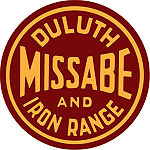 |
HOPPER CAR |  |

A hopper car is a type of railroad freight car used to transport loose bulk commodities such as coal, ore, grain, track ballast, and the like.
This type of car is distinguished from a gondola car in that it has opening doors on the underside or on the sides to discharge its cargo. The development of the hopper car went along with the development of automated handling of such commodities, with automated loading and unloading facilities. There are two main types of hopper car: open and covered.
Covered hopper cars are used for cargo that must be protected from the elements (chiefly rain) such as grain, sugar, and fertilizer. Open cars are used for commodities such as coal, which can get wet and dry out with less harmful effect. Hopper cars have been used by railways worldwide whenever automated cargo handling has been desired.
The DM&N was incorporated in 1891 and the first load of iron ore was shipped to Superior, Wisconsin in October, 1892. (The formation of the railway was necessary after the discovery of high-grade Mesabi iron ore near Mountain Iron, Minnesota by the Seven Iron Men. The D&IR was approached to construct a new branch line, but was not receptive.)
The Merritt's expanded DM&N by laying track to Duluth, Minnesota in 1893 and built an ore dock there. The Merritt's shaky financial position, brought in part to building the Duluth expansion, allowed for John D. Rockefeller to gain control of the railway in 1894. In 1901, Rockefeller sold the DM&N to USS. From 1901 to 1938 the two railways were owned and operated by USS and were operated independently.
Joe built this car in 1913. Joe worked in his garage in the summer months and in the basement in the winter months. He would put in a eight hour day at the MP Shops and then spent most of the night working on the train.
Duluth, Missabe and Iron Range Railway (DM&IR)(DM&N)
Updated 21 Aug 2014